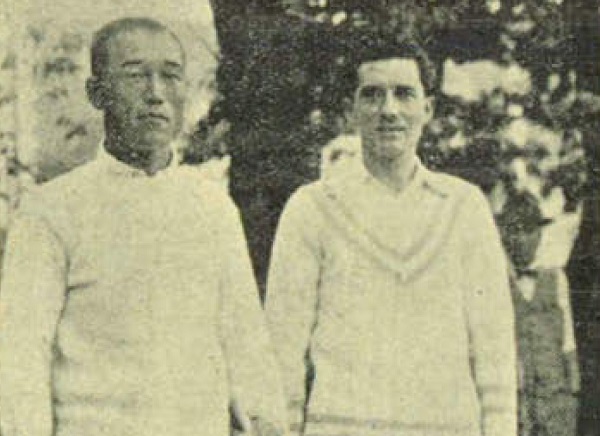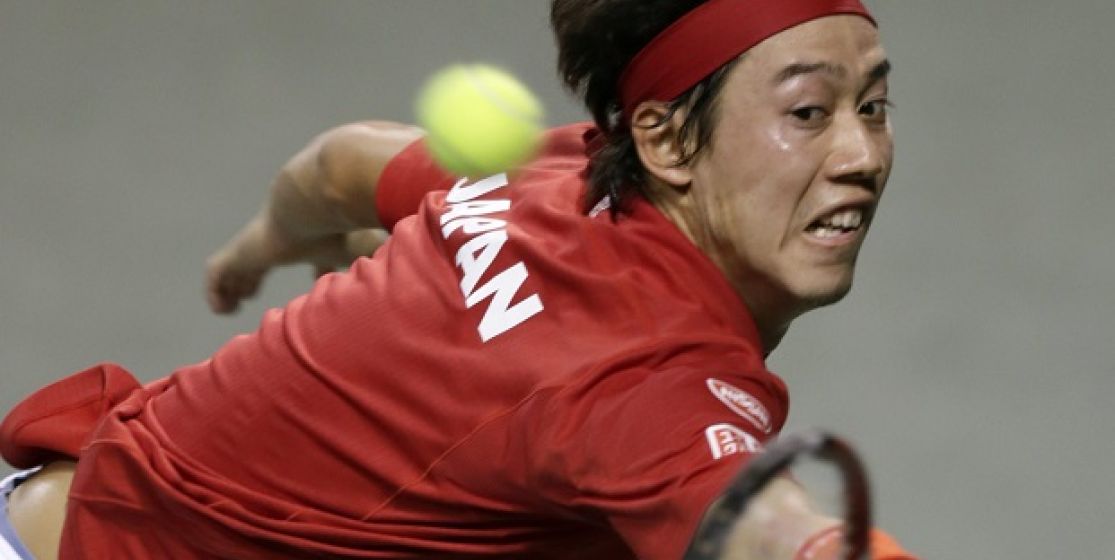The ATP tour takes up residence in the Far East for three weeks. A part of the world that, in recent years, has seen much more success amongst the women than amongst the men. But this was not always the case, the evidence in ten names. Between code of honour, James Bond, Miss Universe and a mysterious "Project 45."
Ichiya Kumagae and Zenzo Shimizu, the pioneers
The rise of Asian tennis. In his book The Art of lawn tennis, Bill Tilden wrote about the first great Japanese players: "You cannot find sharper tennis players or more pleasant opponents than these two Japanese who have earned the respect and friendship of everyone they’ve ever met." It's even easier for the American to praise them since he had the opportunity to stand in their way once on a tennis court: representing Japan in the Davis Cup by BNP Paribas from the first participation of the country in the competition in 1921, Shimizu Kumagae were dominated by Tilden's team, 5 victories to 0. The previous year, "Big Bill" also broke Shimizu's dreams of victory in Wimbledon's final. On his side, Kumagae was the first Olympic medallist in the history of his country, when he brought the silver back from Antwerp in 1920. Deserving then, but no titles. The stage is set.
Jiro Sato, the samurai's honour
A decade later, Japan was under the spotlight again with Jiro Sato. World N ° 3 in 1933, he reached Grand Slam tournaments semi-finals five times (out of nine attempts)... but never made it to the top, mainly barred by Jean Borotra and Jack Crawford, two references at the time. His life ended tragically in 1934 at only 26 years old. Captain of the Japanese Davis Cup by BNP Paribas team that set sails to Singapore to challenge Australia, he feared not to be up to the event and preferred to jump in the waters of the Strait of Malacca at the middle of the night. He left two letters in his cabin: in the first, he apologized for his actions to the captain of the ship and in the second, he explained the shame of being unable to defend his country. In his mind he was no longer a tennis player: a few weeks earlier, the Japanese federation rejected his request to end his tennis career to resume his studies and get married.

The good genes of the Krishnan’s family
Two generations but a unique ball feel. The same ‘bon viveur’ looks, overweight included, in the service of a fine and delicate tennis. Semi-finalist at Wimbledon in 1960 and 1961, Ramanathan Krishnan decided to train his son Ramesh personally, and it showed. He inherited the paternal ease: his flat game led him to the net, his dexterity and his natural sense of anticipation gave the strange impression that he was never running. The both of them fulfilled their potential on grass: the father won the Queen's in addition to his semis at Wimbledon, the son contented himself with quarter-finals on the Centre Court - after winning the competition in juniors - but over his eight ATP titles, he also managed to find the key on clay. Both finally saw the distress of a defeat in the final of the Davis Cup by BNP Paribas, each time against the almighty nation of the moment: Ramanathan in 1966 against Australia, Ramesh in 1987 against Sweden.
Vijay Amritraj, the court is not enough
His name is Amritraj. Vijay Amritraj. And before playing an MI6 agent alongside Roger Moore in the 13th James Bond film "Octopussy", he wrote the finest chapters of the 1970s and 1980s Indian tennis. Selected in Davis Cup by BNP Paribas from the age of 14, his serve-and-volley game went through two decades and helped him win against the greatest: Pancho Gonzales, Rod Laver, Ken Rosewall, Ilie Nastase, Bjorn Borg, Jimmy Connors and even John McEnroe during his fabulous 1984 season. Stuck four times in a Grand Slam's quarterfinal, he nevertheless won 16 tournaments. Before turning to the silver screen, where for the record, he joined his brother Ashok, also a former tennis player, who made his fortune in Hollywood producing thrillers that prominently entered the Z-Movies charts: "Double Impact" with Jean-Claude Van Damme, "The shooter" with Michael Dudikoff or, among many others, Nicolas Cage's “Ghost Rider”. For your eyes only.
Shuzo Matsuoka and the « Project 45 »
The man of the Japanese tennis revival. When, in 1995, Shuzo Matsuoka, then world 108th, made it to Wimbledon's quarterfinals, the whole country shuddered throughout his epic. The local player yet had yet benefitted from what is called a “good table” with Novacek and Javier Frana as main opponents. If his final at the Queen's three years earlier, rich of success against Ivanisevic and Edberg, showed a completely different "face", Wimbledon is a biggest tournament in the world... to the point that Matsuoka has been living though this performance since. Omnipresent in the media in his country - not just in tennis.: the man himself hosts a cooking show – he’s the figurehead of many events held by the federation and his highest ranking of World No. 46 subsequently earned the little Kei Nishikori, his pupil for a while, the sweet codename of "Project 45" or minimum -ranking- to be achieved by the programmed successor of Matsuoka.
Leander Paes, three decades and as many lives
Careful, this legend is still active. In 25 years, Leander Paes had time to compile galore of Grand Slams: in Junior (two titles), in doubles (eight), in mixed doubles (six)... He only missed the showpiece event, the Men's Singles. Now in his forties, the evergreen Indian has just won the U.S. Open again a month ago, forming with Radek Stepanek the oldest pair of doubles ever crowned in a Major. But what gives to Leander Paes his so special status, it's his exceptional ability to exceed himself at the time to defend the national colours. Ranked world 126th during the Olympic Games in Atlanta in 1996, he had to beat Enqvist and Meligeni to snatch the bronze medal and make it to the podium next to Andre Agassi and Sergi Bruguera. Both member and captain of his national team, he’s the active player with the most caps in Davis Cup by BNP Paribas: 120 games played for 88 victories. And he played an active part in the bullfight that saw the Indians ridiculing Leconte and Boetsch's France in the Frejus' arena in 1993.
Hyung-taik Lee and the long-distance journeys
The hatchet man. Without ever going very high in the rankings - 36th at his best in 2007 - the best South Korean in history became famous thanks to his great expeditions, from the anonymity of the qualifications to the greatest central courts. In 2000, he won six matches at the U.S. Open and granted himself the right to play (and lose) against Pete Sampras in the last sixteen. He did it again three years later in Sydney. Out of the "qualifications", he managed the feat to beat Roddick and Ferrero - two players who were No. 1 worldwide this year - to win the only ATP title of his career. He indulged in a final "run" in the second week of the U.S. Open in 2007, eliminating in passing the young Andy Murray. He decided to end his career two years later and opened the "Lee Hyung-taik Academy" in his native province, in order to detect his South Korean heirs.
Paradorn Srichaphan, on top of the rankings
The only one on this list who ever integrated the world Top 10 (on the 9th of May 2003). The Thai Paradorn Srichaphan has nevertheless not left a great mark in Grand Slams, where he never passed the knockout stages. But his spectacular tennis, resolutely aggressive and deeply allergic to clay, earned him five ATP titles and numerous great feats in Masters 1000, where he defeated Roddick, Ferrero, Kafelnikov, Nalbandian... He's also known for his success against Andre Agassi in Wimbledon 2002, and for being the first to defeat Rafael Nadal in a Grand Slam the following year, still in London. Voted "Thai personality of the year in 2002", national star to the point that the country cease all activity to better communicate on TV at each of his finals, Srichaphan ended his career at only 28 years old, often injured and eager to turn to other activities. Married (but since divorced) to the 2005 Miss Universe, Natalie Glebova, he tried his luck in cinema, as one of the lead of a "300" movie, the Thai way. Enjoy.
Kei Nishikori, the hope of a nation
The last pearl to date, brood from a young age by the Japanese federal authorities, he left the country to enrol in the champions factory of Nick Bollettieri in Florida and arrived like a Björn Borg made in Rising Sun on the ATP Tour, always surrounded by countless fans and television crews. World 11th at 23, three titles to his name, quarter-finalist at the Australian Open and the scalps of Federer and Djokovic on his belt, Kei Nishikori has largely responded to the enormous expectations placed upon him. And if has stagnated in recent months, the room for improvement remains significant. To the point to emulate Li Na one day, the only Asian, men and women alike, to have ever won a Grand Slam?






